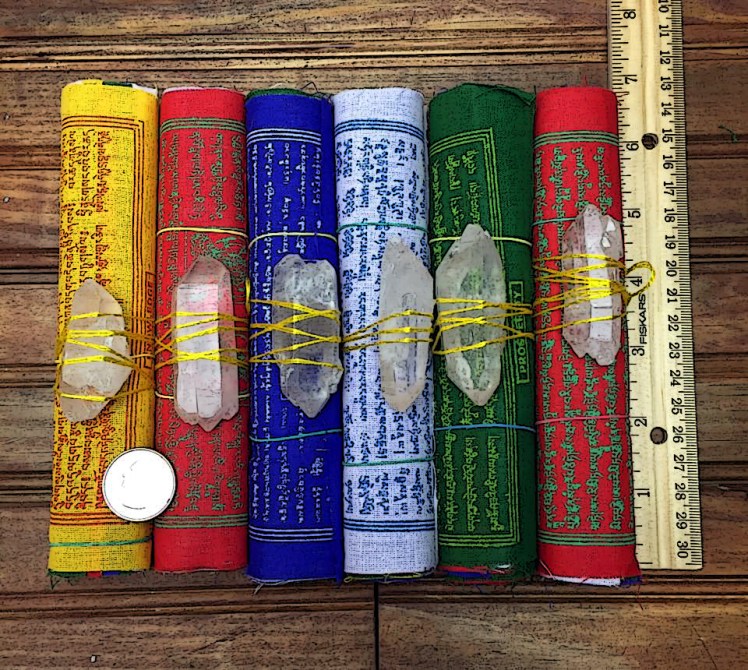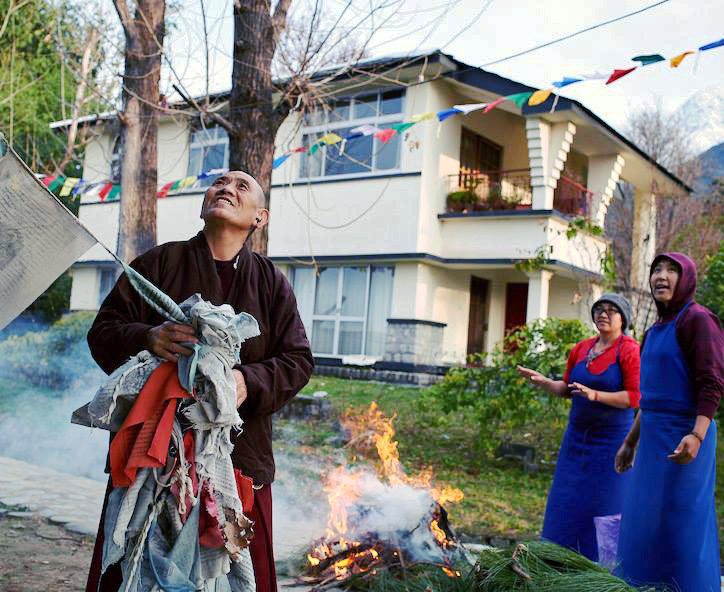
There is nothing more beautiful than watching fluttering of the colorful Tibetan Prayer Flags. For the vast majority of Tibetan people, it is more than just a pretty piece of cloth. It is how they renew their hopes for the world by mounting new flags alongside the old.
It is a sight that moves people, but only a few know its true drift. Let us simplify this for the benefit of our readers. Read on.
#1. Prayer flags are not a medium to carry prayers to the Gods.
“The flags do not carry prayers to the gods, a common misconception. Rather, the Tibetans believe the prayers and mantras passed via the wind to spread the good will and compassion into all pervading space,” clarifies Nima Lama.
The ancient Buddhist prayers produce a spiritual vibration that gets carried by the wind across the land. All beings touched by the wind gets uplifted.
#2. The Anatomy of a Tibetan Prayer Flag
Prayer flags are made of block-printed fabric using traditional printing techniques going back hundreds of years. “The writing and images on prayer flags were painted by hand, one at a time. Woodblocks, carefully carved in mirror image relief, were introduced from China in the 15th century. This invention made it possible to reproduce identical prints of the same design. Traditional designs could then be easily passed down from generation to generation,” explains Timothy Clark.

Prayer flags typically come on ropes to be hung in horizontal displays or printed on long narrow strips of cloth that are tied on vertical poles. Prayer flags on ropes are printed on five different colors of cloth (yellow, green, red, white and blue). So sets are always in multiples of five. Pole flags are either a single solid color or the five colors sewn together into one flag. They range in height from about 3 feet to 40 feet or more. Pole flags often have colored streamers or ‘tongues’ that are imprinted with special increasing mantras meant to increase the power of the prayers written on the body of the flag. It is also common to see displays of many plain white prayer flags on poles erected around monasteries and pilgrimage sites*.

#3. Deciphering a Tibetan Prayer Flag
The traditional prayer flags are printed with the Wind Horse (Lung-ta) and four supernatural creatures (Garuda, Dragon, Lion, and Tiger). These five animals carry these prayers as blessings upon the wind to the four corners of the earth. They come with Buddhist auspicious signs such as Buddha, Green Tara, Padama Sambhava etc.

#4. Prayer Flags are replaced with new ones each year.
This is done religiously on Losar, The Tibetan New Year. “The prayers of a flag become a permanent part of the universe as the images fade from exposure to the elements. Just as life moves on and is replaced by new life, Tibetans renew their hopes for the world by continually mounting new flags alongside the old,” says Nima Lama. The Old Prayer Flags are burned once replaced.
#5. Hanging Prayer flags on certain inauspicious days is said to bring negative energy.
Many Tibetans are often seen taking off the flags on certain inauspicious astrological dates.
For 2016 the following dates are inauspicious to hang flags: February (2016): 3, 14, 26 – March: 12, 24 – April: 5, 11, 23 – May: 5, 7, 9, 21 – June: 6, 7, 20 – July: 14, 26 – August: 10, 22 – September: 8, 20 – October: 5, 17, 28 – – November: 9, 20 – December: 6, 8 – January (2017): 2, 13, 25, 28 – February: 21
Prayer flags are a powerful way to remind us of an inward journey. They are a great way to support the Tibetan people. If placing the Prayer flags in your home, office or outdoors, keep in mind the sanctity it carries.
 Buy Tibetan Prayer Flags and support a cause : Tibetan Nun Project
Buy Tibetan Prayer Flags and support a cause : Tibetan Nun Project
Lead Picture Credits: United Nations for a free Tibet | Citations*: Timothy Clark – CA Copyright Radiant Heart Studio | http://mydzi.blogspot.in | Tibetan Nun Project

Fantastic post, buddy! Have been to a few treks in the HImalayas.. and the flags are a common occurrence! Thanks for the informative post! Can we get these flags somewhere in Delhi?
LikeLiked by 1 person
Thanks Desh. You can get the Prayer Flags at Tibetan (Monastery) Market near Kashmiri Gate.
LikeLike
Absolutely loved the article! Great one 🙂
LikeLiked by 1 person
Thank you Deepika 🙂
LikeLike
Really interesting!
LikeLike
Gracias!
LikeLike
Interesting post, just hung one of these yesterday in my verandah 🙂
LikeLike
I loved this article, thank you so much!!
🙂
LikeLiked by 1 person
Buy Combo Of Tibetian Buddhist Prayer Flags online at best price @ Divyamantra.com. Easy Return-COD-Only Genuine Products-7 Day Replacement Guarantee.
LikeLike